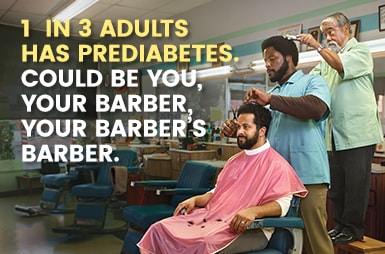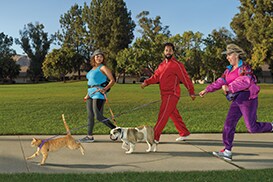Prediabetes: You Could Be That 1 in 3

The numbers are in, but what do they mean? Here’s how our latest PSAs are helping people see themselves in a really important number and take action to learn their prediabetes risk.
More than 84 million. That’s how many American adults have prediabetes, and 90% of them don’t know they have it.
Statistics like these are a little hard to wrap your head around. You might be 1 in 84 million. What does that even mean?
That same fact put another way: “1 in 3 US adults.” It could be you, your favorite brother, or your other brother who has prediabetes. You, your boss, your boss’s boss. When you can see yourself and the people you know in the stats, you get it in a whole new way.
That’s the thinking behind Phase 3 of CDC’s award-winning Prediabetes Awareness Campaign. These latest public service announcements (PSAs) aim to change how people think about prediabetes – maybe even get them to think about it for the first time – by making it personal.
The PSAs feature an average guy along with two different people in various parts of his life, from work to the barbershop to a family dinner. The message for viewers: You or some of the people you know could be that 1 in 3.
The Funny Thing Is …
People’s attention is a limited resource; entertain them, and the message is more likely to stand out and be remembered. Each scene in this year’s funny, quirky PSAs surprises viewers as it reveals the connection between the main character and two other people he knows. There’s a hopeful message along with the humor and the very real risk: with early diagnosis, prediabetes can be reversed. That’s why it’s so important to help the 84 million Americans with prediabetes know their risk and take action.
And while the new creative is fresh, overall campaign goals are unwavering:
- Drive people to DoIHavePrediabetes.org to take a 1-minute risk test.
- Urge them to talk to their doctor about their prediabetes risk and get a blood test to confirm a potential diagnosis.
- If they have prediabetes, encourage them to enroll in CDC’s National Diabetes Prevention Program. DoIHavePrediabetes.org shows them how to sign up.
Prediabetes can be a health wake-up call for many. People who know they have prediabetes are more likely to make important lifestyle changes—losing weight, eating healthier, and being more active—to help prevent or delay type 2 diabetes.
Behind the Scenes
The new PSAs build on Phases 1 and 2 of the campaign, a unique partnership among the American Medical Association, CDC, and the Ad Council, designed to address one of our nation’s most pressing health issues. Consumer testing found that this year’s three-person scenarios help make the “1 in 3” statistic more relatable and urgent. The PSAs were developed with pro bono support by Ogilvy in New York for the Ad Council.
Phase 3 continues to target adults 40 years of age and older throughout the nation. PSAs are available in both English and Spanish across all media types.
Getting the Word Out
The PSAs are running on donated ad space and airtime, per the Ad Council’s model. Insights from previous phases of the campaign are used to target audiences in the most appropriate TV, radio, digital, print, outdoor, and other media channels. The Ad Council is distributing and promoting the PSAs to more than 30,000 national and local media outlets across the country for the widest reach and greatest impact. And as in prior phases, more opportunities are expected to arise.
How We’re Doing
Results continue to far exceed the campaign’s most ambitious goals. Since January 2016, more than 2 million people have visited DoIHavePrediabetes.org, and close to 2 million people have completed the prediabetes risk test. The campaign videos have been viewed over 1.5 million times online.
An Ad Council continuous tracking survey of adults at high risk for prediabetes reveals significant increases in prediabetes awareness, adults seeking information about prediabetes, and adults planning to talk to their doctors about prediabetes. Phase 3 promises to drive even more Americans to take the risk text and learn where they stand.
Don’t wait — see the new PSAs here, and stay tuned for updates as more people at risk take action to prevent type 2 diabetes. Will you?






















.jpg)












No hay comentarios:
Publicar un comentario